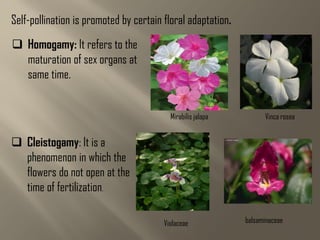Pollination
- 2. POLLINATION The term pollination refers to the transfer and deposition of pollen on the stigma of the flower. It is of two types: Natural pollination: which occurs naturally in plants. Induced pollination: which is carried out by artificial means. Natural pollination is of two types: Self-pollination Cross pollination
- 3. SELF-POLLINATION It involves the transfer of pollen grains from the anther to the stigma of the same flower(Autogamy) or another flower of the same plant (Geitonogamy). Examples: Ground Nut BarleyPea plant
- 4. Self-pollination is promoted by certain floral adaptation. Mirabilis jalapa Vinca rosea Cleistogamy: It is a phenomenon in which the flowers do not open at the time of fertilization. Violaceae Homogamy: It refers to the maturation of sex organs at same time. balsaminaceae
- 5. ADVANTAGES OF SELF-POLLINATION i. Parental charecters are preserved indefinitely. ii. The flowers need not to be large. iii. Fragrance and nectar production is not required, which saves considerable nutrient material of plants. DISADVANTAGES OF SELF-POLLINATION i. Continued self-pollination may lead to weakening of the off-springs. ii. Seeds produced will be poor in quality. iii. The defective character of plants cannot be eliminated.
- 6. CROSS POLLINATION It involves the transfer of pollen grains from the anther of a flower to the stigma of another flower of different plant(Allogamy). Pollination between flowers of different genetic constitution is known as xenogamy. Examples: Sunflower, date palm, maize etc. Cross pollination is favoured by certain adaptations. • Dicliny: plants bearing unisexual flowers posses only one kind of sex organs(male or female). Example: Papaya Mulberry
- 7. Dichogamy: It refers to maturation of sex organs at different time period. It shows two conditions 1. Protandrous: here anthers mature before stigma. Example: Rubiaceae, Malvaceae, Labiatae. 2. Protogynous: here stigma matures before the anthers. Example: Mangolia, Michalia, Adhatoda.
- 8. Heterogamy: The phenomenon of bearing two types of morphological dissimilar flowers. Ex: Primrose. It bears two types of flowers. Long-styled or Pin eyed: Flowers bearing long style and short stamens. Short-styled or thrum eyed: Flowers bearing short style and long stamen.
- 9. Herkogamy: In certain flowers, morphological barriers develop which makes self pollination impossible. Example: Calatropis Zeuxine Self-Sterility: Flowers in which pollens are incapable of causing fertilization. Example: Maize.
- 10. AGENTS OF CROSS POLLINATION In angiosperms, pollens are immotile and thus, have to be carried to the stigma by external pollinating agents. Depending upon their nature the agents may be 1. Biotic agents: Insects, Birds, Snails etc. 2. Abiotic agents; wind, water. BIOTIC AGENTS i. Entomophily: It refers to the pollination brought about by insects. Examples: Salvia, Yucca, Ficus.
- 11. ii. Ornithophily: It refers to the pollination brought about by birds. Examples: Salmalia, Erythrina, Callistemon. iii. Cheiropterophily: It refers to the pollination brought about by bats. Examples: Adansonia, Eperua falcata.
- 12. iv. Malacophily: It refers to the pollination brought about by snails & slugs. Examples: Alocasia, Lemna, Colocasia. v. Myrmecophily: It refers to the pollination brought about by ants. Examples: Medicago sativa, Melitotus officinalis.
- 13. vi. zoophily: It refers to the pollination brought about by animals. Examples: Arctium, Galium aparine. ABIOTIC AGENTS i. Anemophily: It refers to the pollination brought about by winds. Examples: Wheat, maize, coconut.
- 14. ii. Hydrophily: It refers to the pollination brought about by water. It is of two types; 1. Ephydrophily: Pollination occuring on the water surface. Examples: Elodes, Hydrilla. 2. Hyphydrophily: Pollination occuring beneath the water surface. Examples: Najas, Ceratophyllum.
- 15. ADVANTAGES OF CROSS-POLLINATION i. Off-springs are healthier. ii. New varities may be produced. iii. Helps in increase seed production in cereals. DISADVANTAGES OF CROSS-POLLINATION i. The pollination is not always certain. ii. A large number of pollens are to be produced to ensure chances of pollination. iii. If in a crossing, a diseased plant gets involved, it will give weak off-springs.
















